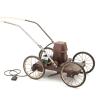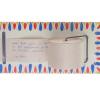Tune in, turn on...the recorder
It has been reported that most of the population of the GDR turned their eyes to the West every evening by watching Western television programmes.
The reception around West-Berlin and close to the West German border was easy, but in the rest of the country one needed special antennas which could not be bought in a store. For this reason many people tried to construct antennas themselves, some looking like normal TV antennas and others trying different shapes. The example shown here is quite untypical.
Particularly for younger people, participating in international youth culture went via another medium. The audio-cassette, like the reel-tape in the 1950s and 1960s, was a common mode to record music and was especially popular with young people all over Germany. Before internet-based resources cassettes were the main means of music sharing - and pirating. The cassette recorder in the GDR was introduced shortly after the Philips company introduced them in 1967.
It was almost impossible to buy Western rock music from records since the GDR did not pay royalties and records from the West were forbidden to import. But they were available in Hungary and smuggled by sympathetic grandmas. Berlin residents could record from various radio stations, the American Forces Network (AFN), British Forces Broadcasting Service (BFBS) and German Rundfunk im Amerikanischen Sektor (RIAS) and Sender Freies Berlin (SFB) in the West were the main sources.
Later, the East-Berlin station DT64 tried to attract young listeners with a good portion of Western music, and they openly expected that listeners would tape what they heard.
 Previous Story
Next Story
Previous Story
Next Story
How to cite this page
Andreas Ludwig, 'Tune in, turn on...the recorder', Inventing Europe, http://www.inventingeurope.eu/story/tune-in-turn-on-the-recorder
Sources
- Abc des Ostens. 26 Objektgeschichten, edited by Dokumentationszentrum Alltagskultur der DDR. Cottbus, 2003.
- Alltag: DDR. Geschichten, Fotos, Objekte, edited by Dokumentationszentrum Alltagskultur der DDR. Berlin: Ch. Links, 2012.
- Fortschritt, Norm & Eigensinn. Erkundungen im Alltag der DDR, edited by Dokumentationszentrum Alltagskultur der DDR. Berlin: Ch. Links, 1999.
- Guter Rat, Verlag für die Frau, Leipzig, 1965-1990 (formerly Guter Rat für heute und morgen).
- Krössin, Dominque. “Wie mach ich´s mir selbst? Die Zeitschrift practic und das Heimwerken”, in: Wunderwirtschaft. Die DDR-Konsumkultur in den 60er Jahren, edited by the Neue Gesellschaft für bildende Kunst,160-165. Köln, Weimar, Wien: Böhlau, 1996.
- Magazin für Haus und Wohnung. VEB Verlag für Bauwesen Berlin.
- Merkel, Ina. Utopie und Bedürfnis, Die Geschichte der Konsumkultur in der DDR. Köln/Weimar/Wien: Böhlau, 1999.
- Practic. Verlag Junge Welt, Berlin, 1967-1990 (formerly: Modellbau und Basteln).
- Stumpfe, Mario. “Geht nicht, gibt´s nicht. Westempfang im Eigenbau.” In Alltag: DDR. Geschichten, Fotos, Objekte, edited by Dokumentationszentrum Alltagskultur der DDR, 180-183. Berlin: Ch. Links, 2012.
- West German TV news clip on: http://www.youtube.com/watch?gl=DE&hl=de&v=IbIocNFHnTM
- Wunderwirtschaft. Die DDR-Konsumkultur in den 60er Jahren, edited by the Neue Gesellschaft für bildende Kunst. Köln, Weimar, Wien: Böhlau, 1996.




















